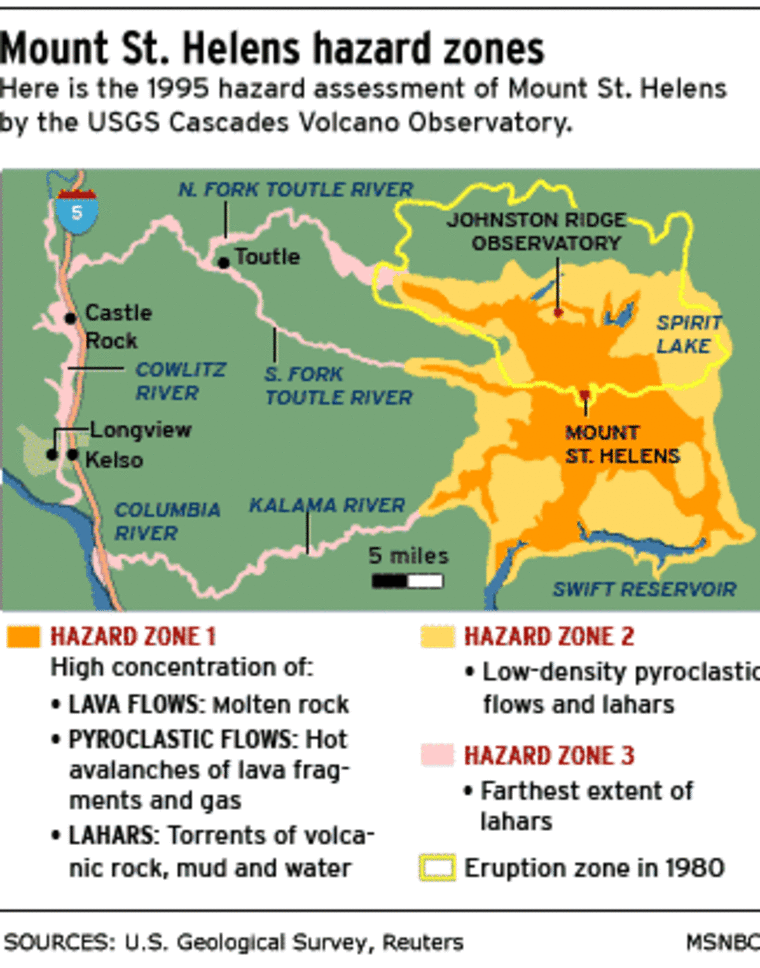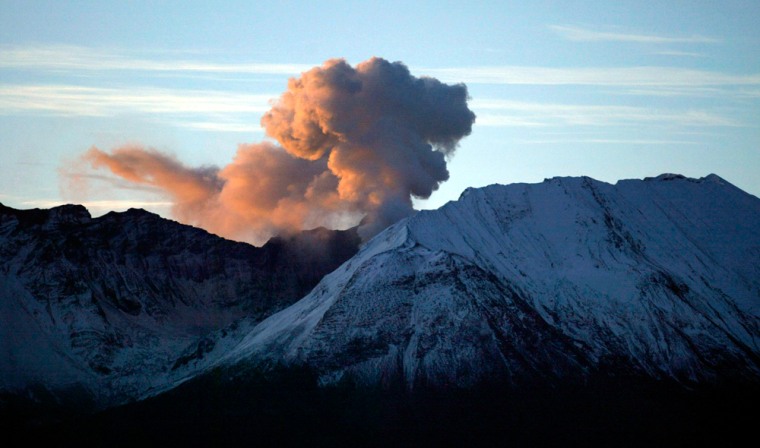Mount St. Helens gave off more steam Monday morning, with a small cloud drifting up from the snow-dusted crater as the sun rose.
Within the mountain, however, seismic activity remained relatively low, said Jeff Wynn, chief scientist for volcano hazards at the U.S. Geological Survey’s Cascades Volcano Observatory.
Researchers are hoping to use an unmanned craft called the Silver Fox to fly over the volcano and take measurements from the crater. The Silver Fox is just five feet long and weighs a mere 22 pounds.
Signs magma rising
New thermal images show parts of the lava dome in the mountain’s crater are piping hot — a sign that magma continues rising. Scientists say temperatures in some spots could be as high as 570 degrees.
They also have detected a significant rise in emissions of carbon dioxide and other gases associated with molten rock.
While seismic activity is low, the mountain continues spewing steam and, sometimes, ash.
On Sunday, a crooked plume of steam rose at least 500 feet above the rim of the crater, dissipating as it drifted about a mile south of the 8,364-foot-high volcano.

Scientists believe the steam was created when part of a bulge or bubble broke off on the south side of the dome-shaped rock formation inside the crater, taking along some of the glacier in the area. The steam was mostly likely created as water from the melting ice seeped down to hot rock layers, said USGS geologist John Pallister.
‘Lazy conductive rise’
Scientists said Sunday’s steam cloud may have carried some old volcanic ash from the 1980s, the last time the mountain erupted.
Willie Scott, a geologist with the U.S. Geological Survey, described Sunday’s emission as a “very lazy conductive rise of this warm, moist air,” unlike previous weeks’ vigorous bursts that threw up ash, large pieces of rock and glacier ice.
Scientists do not anticipate anything similar to the May 18, 1980, blast that killed 57 people, blew 1,300 feet off the top of the peak and paralyzed much of the inland Pacific Northwest with gritty volcanic ash.
The bubble of upwelling rock has risen to at least 330 feet since Sept. 30, Pallister said.
Earthquakes were less frequent and weaker on Sunday, following two days of increased activity when quakes of magnitude 2.4 happened every two minutes.
“What has been peculiar about these earthquakes is that there seems to be a disproportionate number of them that are uniform in size,” said University of Washington seismologist Tony Qamar.
It indicates that pressurize in the system is very uniform, which may suggest magma is constantly moving upward, he said. “The pressure will build up, the rock will break, and then you’ll get an earthquake,” he said.
Scientists cannot say exactly how far the magma has risen.
Activity is expected to ebb and flow, and the most likely scenario now is weeks or months of occasional steam blasts and possibly some eruptions of fresh volcanic rock.
The level alert remained at “volcano advisory” Sunday, or the third-highest level. Scientists have said an eruption would have to be imminent to raise the alert.
However, officials have said an eruption could occur with very little warning.
Activity is expected to ebb and flow, and the most likely scenario now is weeks or months of occasional steam blasts and possibly some eruptions of fresh volcanic rock.
Thousands of small earthquakes have shaken the peak in the Cascade Range since Sept. 23. The volcano spewed clouds of steam mixed with small amounts of old volcanic ash each day from Oct. 1 through Oct. 5.
The alert level was lowered Oct. 6. The downgrade indicated the probability of a life-threatening eruption had decreased significantly since Oct. 2, when thousands of people were evacuated from areas around the mountain.
Geologists do not anticipate anything similar to the May 18, 1980, blast that killed 57 people, blew 1,300 feet off the top of the peak and paralyzed much of the inland Pacific Northwest with gritty volcanic ash.
